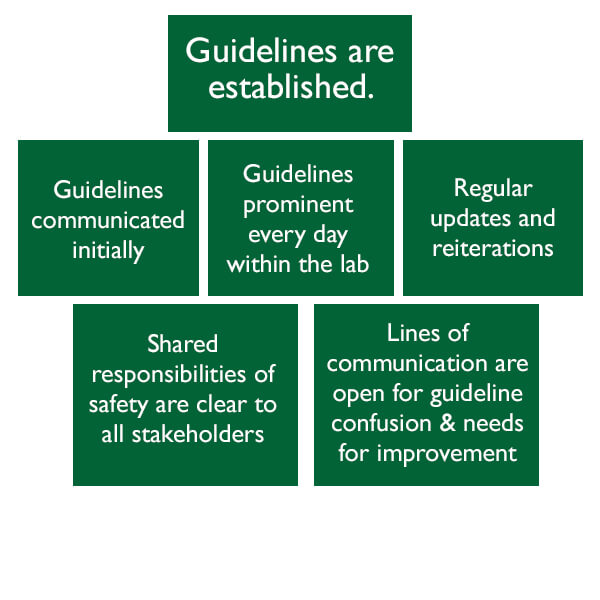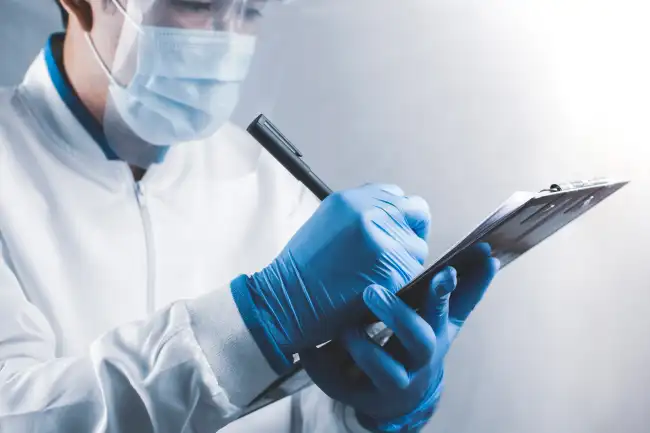First Step for Lab Safety Success: Make Your Policies Clear
Clearly communicating your guidelines to researchers is the first essential step to promoting lab safety. When an accident occurs in a lab, it is easy to blame the incident on a lack of rule enforcement. Often overlooked, however, is the possibility that a researcher who has violated a policy may not have even been aware of this violation. Developing straightforward guidelines and then educating researchers about these guidelines with trainings and visuals in the laboratory help EH&S departments to educate researchers and hold graduate students, post docs, PIs, and other staff responsible for their own safety.
Clarity of guidelines can be broken down into two parts – first, actually establishing guidelines around all aspects of laboratory safety; and second, communicating these policies. Let’s be clear, though – “communication” is more than simply having guidelines stated in handbooks and then signed off by a researcher. Communication means having an open relationship between EH&S and researchers. With continuous training and outreach, safety becomes a conversation rather than an edict. Signs help to keep safety top-of-mind for researchers, since EH&S personnel cannot always be present in the lab. Safety days are an excellent way to open up a discussion with lab researchers and give a hands-on approach to a safety refresher. Blogs, monthly meetings, newsletters, and social media posts are other ways for EH&S departments in academia to maintain a dialogue with researchers.

Since safety is a shared responsibility, clarity of guidelines also relates to roles that different people have in communicating safety. It must be clear what EH&S is responsible for versus what PIs are responsible for versus what researchers themselves are accountable for. In the instance of a lab accident, if a researcher was not aware of a certain policy to follow, that lack of knowledge needs to be traced upstream to PIs, and others who are responsible for educating people about these policies.
Questions to consider during a tabletop safety discussion with your department:
-
How do you make your Chemical Hygiene come alive within the lab? What visibility does it have beyond written text in a handbook?
-
If revisions are made to your standard operating procedure, do you make those changes clear to every person operating within the lab?
-
How do you make sure that lab policies are clear to researchers who do not speak English?
-
Are all levels of management on the same page? Chemical Hygiene Officer, Department Chair/Director, Safety Committee, Lab Supervisor, Lab Personnel? Do you hold regular meetings to ensure that everyone is on the same page? How are those organized? Do you talk about which policies might be unclear?
-
What signs do you have around the lab? Are there others that you should have but do not yet exist? Who can you get involved to help produce these?
-
Do you make sure that housekeeping rules are clear? Are researchers aware of how their work space needs to be kept? Is it just a written policy or are there people in the lab giving friendly reminders?
-
How clear is your emergency action plan (EAP) for accidents and spills? Has anyone this plan with researchers? Yes? When was the last time? How do you make it clear within the lab which personnel should be called in an emergency situation? If you have a vendor that should be called directly, are researchers aware of what number to call? Magnets and stickers can help to raise ER awareness.
-
How do you make researchers aware of which type of PPE to wear for different types of research? What happens if a researcher is working with new chemicals that he/she has never dealt with before?
Start today by performing a safety gap audit within your labs. You can hire an outside company with an objective view to see where your policies are not being upheld and what guidelines may not be clear to researchers. Compliance software can provide you with data and analytics that will physically graph out areas of policy violation within the lab. This shows you where you need to clarify rules and increase accountability and training. You might also consider surveying researchers to understand the standard operating procedures that they are unfamiliar with or unsure about. Ask your researchers about minor injuries and near misses that they have seen during their time in the labs.
Having an open conversation about what has gone wrong in the past will help you to develop a tightened safety plan for the future. If you find that stakeholders are hesitant to provide feedback, you might circulate a feedback form that allows anonymous responses. Ask questions about where safety is lacking, and how behaviors can be improved at an institutional level as well as within each lab. Keep in mind PPE, procedures for each type of experiment, limits on chemical amounts, et cetera.
Stay proactive by holding regular meetings with all stakeholders throughout the year; this will help you to constantly gauge any gaps in safety.






